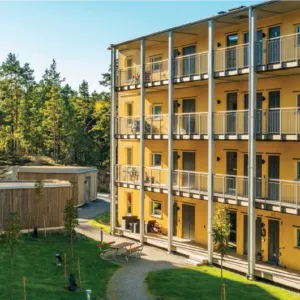Table of Contents
Ingvar Kamprad, the visionary founder of IKEA, died in January at age 91. While many of us connect Kamprad to the iconic IKEA brand, few of us know that he also was instrumental in transforming the housing industry.
Kamprad, along with the international construction firm Skanska, created a new way of producing living spaces for the masses. Rather than simply find out how efficiently homes could be built, Kamprad and the president of Skanska decided to create homes for a large and overlooked segment of the housing market—the multitudes of average Swedish citizens.
“The vision is to create homes for the many,” he said. “People should be able to pay for their homes themselves. It’s much better than subsidies in the long run. Our challenge is to keep the price low.”
And they wondered: What could a nurse, sales clerk, single parent or student afford to pay to own their own home? In the end, their research found that a single nurse with a child could spend $380 per month. That number became the standard on which all other decisions were made.
Employing manufacturing technologies, automation and production systems that made IKEA famous, “BoKlok” homes were born. Boklok, Swedish for “living smart,” became an instant success. Boklok homes are built in a controlled indoor environment, designed with large windows and well-thought-out floor plans. The homes are stylish and energy efficient, but they are considered cozy, not flashy. Each home includes IKEA furnishings, right down to the hangers in the closet.
Boklok homes are sold at IKEA stores in Sweden, Norway and Finland. Demand is so high that prospects are selected from a lottery. About 1,200 Boklok homes are built per year, and capacity is being increased by more than 50 percent due to demand. Since its inception, the joint venture between IKEA and Skanska has produced more than 11,000 homes.
Thinking of Kamprad’s legacy brings to mind another visionary who made enormous contributions to our industry. While not as widely known as Kamprad, Marshall Erdman may be considered the father of panel processing and was one of the earliest producers of prefabricated buildings.
As a contemporary of Frank Lloyd Wright, Erdman built many of Wright’s buildings. Erdman was well known for producing prefabricated medical offices, complete with “exam-rooms-in-a-box” delivered with cabinetry, nearly complete and ready to use. Erdman launched Techline (acquired by Stevens Industries), one of the first high-end panel processed residential and office furniture producers, which is still widely revered today.
I have wonderful memories of escorting Erdman to the press room at the LIGNA fair in Hannover, where we would visit for hours. I had dinner with him several times and will always remember the experience. His creativity and passion for the industry have always been a great inspiration for me. I was fortunate to have known him. Marshall died in 1995.
Ingvar Kamprad and Marshall Erdman were pioneers. Both are gone, but their disciples live on.






